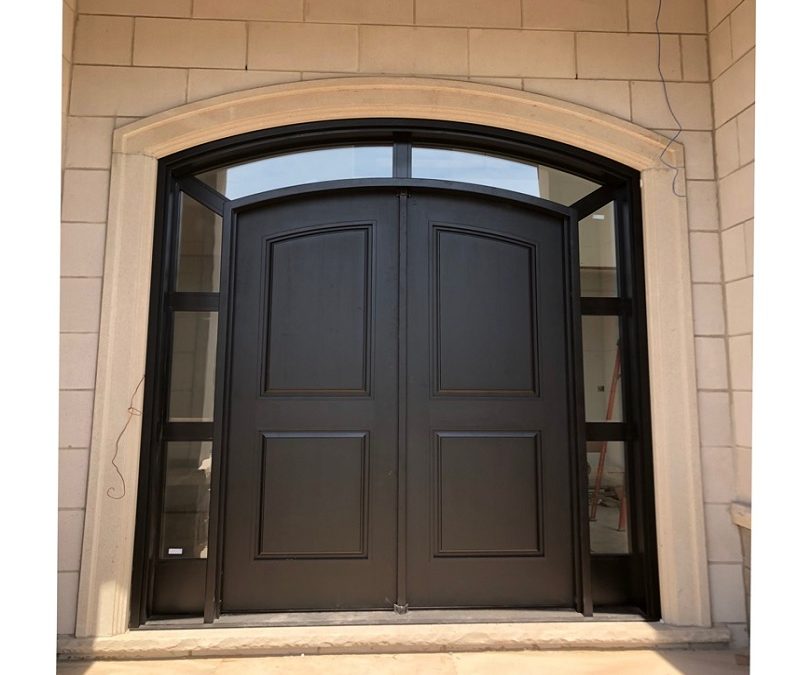Have you ever wondered why wood looks a certain way when stain is applied? Are those stain results planned, or by chance…or a little of both? Well, the expert door manufacturers from Master Doors will be the first to tell homeowners that fine wood door making and an extensive knowledge of stained wood cuts go hand in hand. Also, that wood staining and the choice of wood cuts are critical to getting the perfect wood door design and finish from the outset.
That’s why our team has collected this in-depth guide on how stains and various types of wood cuts can shape both the aesthetics and functionality of wood doors.
Understanding Stained Wood Cuts for Exterior & Interior Doors
Stained wood is a popular way to enhance custom wood doors. As such, understanding the characteristics of common flat, quarter, and rift cuts is critical for achieving the perfect wood stain finish, as each plays a distinct role in wood staining.
- Flat Cuts produce bold, swirling patterns.
- Quarter Cuts result in vertical, straight-grain patterns.
- Rift Cuts, which are variations of quarter cuts, produce more linear and subdued grain patterns compared to quarter cuts.
Of course, choosing the right cut of wood for door construction goes well beyond aesthetics. Wood cuts also greatly impact durability and longevity by affecting stability, wear resistance, and resistance to decay. Quarter and rift cuts, with vertical grain patterns, often result in more stable wood, while quarter-sawn wood tends to be harder and more wear-resistant. Additionally, the presence of heartwood in certain cuts can enhance resistance to decay and insects.
Flat Cut: Unveiling Unique Patterns
The flat cut method is known for precision and distinctiveness. This cut involves rotating a log against a fixed blade to reveal exquisite patterns in the wood grain. The result? Mesmerizing, stained wood cuts that add a touch of elegance to any project.
The charm of the flat cut lies in its ability to showcase diverse patterns, making it a highly preferred choice for wood finish enthusiasts. This technique is particularly suitable for highlighting the natural beauty of wood. Master Doors often uses flat cuts when intricate patterns are desired to enhance the overall aesthetic of stained wood doors.
From creating eye-catching wood cuts to achieving interesting wood stain finishes, flat cuts offer versatility. Its compatibility with various wood species also makes it an ideal choice when experimenting with natural wood stains.
Quarter Cut: Classic Elegance in Grain
Quarter cuts impart a timeless charm and refined appearance that enhances the beauty of wood. This wood finishing method involves first quartering a log and then cutting each quarter separately into boards. Boards cut using this technique tend to be expensive due to the amount of waste produced during the cutting process.
Quarter cut wood boasts distinctive features, however, showcasing a straight grain with striking medullary rays. Wood staining quarter cut boards brings out the best in fine-grained hardwoods, such as oak and cherry, while natural wood stains accentuate the wood’s inherent characteristics, providing a sophisticated finish.
Well-suited for stained interior or exterior wood doors, this method can elevate practically any space with the luxury of finely crafted wood.
Rift Cut: Modern Simplicity & Durability
A variation of the quarter cut method, rift cut wood marries modern simplicity with durability. Unlike other stained wood cuts, rift cuts are quite precise and designed to enhance natural grain patterns for staining. Also, they result in distinctive, angled, linear patterns that produce a refined, contemporary look.
As such, this type of cut is much sought-after for interiors, especially for stained wood doors separating rooms, like French doors. Even as demand for more and more distinctive wood cuts has risen, the rift cut remains a sophisticated choice for many.
Choosing the Right Cut for Your Project
With any woodworking project, whether it’s in a classic or modern setting, the synergy between wood cuts and wood finishes plays a key role.
The choice of wood cut is critical for achieving the desired look, feel, and level of durability. For example, understanding wood movement and stability is crucial for preventing issues such as warping or splitting over time.
Another factor to consider is the right wood finish for the project. Whether you’re going for a natural wood stain look or a more robust stained wood cut, the choice greatly influences overall results.
Contact Canada’s Leading Door Manufacturers Today
As you can see, the versatility of stained wood cuts is a testament to the transformative power of wood staining. Knowing about the various types of wood cuts can help you make better, more informed choices that ultimately impact the look and feel of your stained wood doors and your satisfaction with them.
With the high-quality materials from Master Doors, we ensure that every project becomes a masterpiece with the right custom design and installation process. Our team is committed to creating a door that perfectly matches your requirements, whether it be a French door, exterior door, or wine cellar door.
Learn more by contacting us online today or calling (905) 597-9011.


